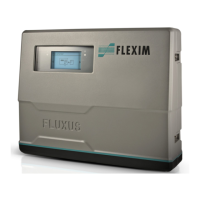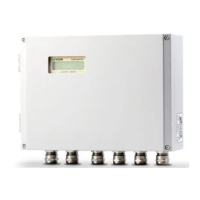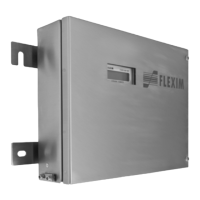9 Measurement
9.3 Start of the measurement FLUXUS WD
2018-07-16, UMFLUXUS_WDV1-3EN
88
• Mount the transducers on the pipe adjusting the transducer distance.
• Press ENTER.
The diagnostics window is displayed, see Fig. 9.1.
Fine adjustment of the transducer distance
The bar graph AMP shows the amplitude of the received signal, see Fig. 9.1.
The bar graph SCNR shows the ratio useful signal to correlated noise signal.
• Shift one of the transducers slightly within the range of the recommended transducer distance until the bar graph reach-
es the max. length.
• In case of large deviations of the diagnostic values, see Tab. 9.5, check if the entered parameters are correct or repeat
the measurement at a different point on the pipe.
• Press ENTER.
Fig. 9.1: Diagnostics window
1 – additional diagnostic
2 – additional diagnostic
3 – amplitude (bar graph)
4 – SCNR value (bar graph)
Tab. 9.4: Diagnostic values
display
1
explanation
key
(1 in Fig. 9.1)
SNR ratio useful signal/noise signal
signal quality Q bar graph has to reach max. length
By pressing key it is possible to display the numeric value instead of the
bar graph.
GAIN= 86 dB signal amplification
If the current value of the amplification is higher than the max. amplification,
the current value is displayed with →FAIL!.
AMP= 44% G= 86 dB amplitude and gain
SCNR ratio useful signal to correlated noise signal
key
(2 in Fig. 9.1)
SNR ratio useful signal/noise signal
signal quality Q bar graph has to reach max. length
By pressing key it is possible to display the numeric value instead of the
bar graph.
■<>■ transducer distance
SCNR ratio useful signal to correlated noise signal
1
In order to avoid doubling, a value already be displayed in one of these lines will be ignored in the other.
Tab. 9.5: Recommended diagnostic limits
good measurement measurement at limit measurement not possible
SCNR 30 dB (> 50 %) 20 dB SCNR 30 dB (0 % < SCNR 50 %) SCNR 20 dB (= 0 %)
SNR 15 dB 0 dB SNR 15 dB SNR 0dB
GAIN 98 dB 98 dB GAIN 113 dB GAIN 113 dB

